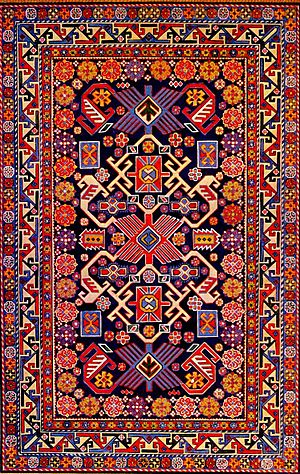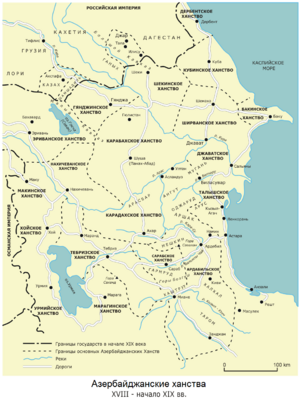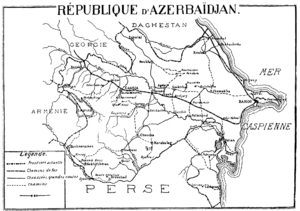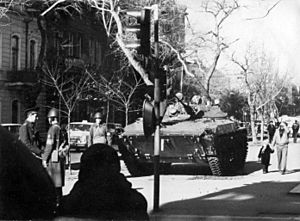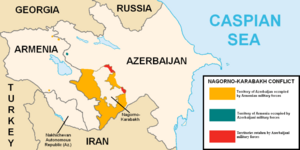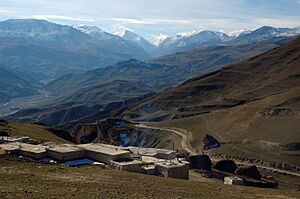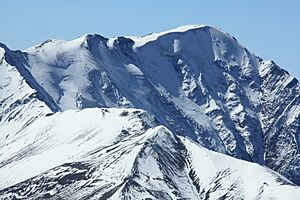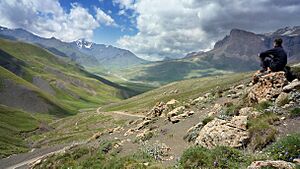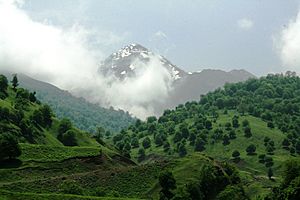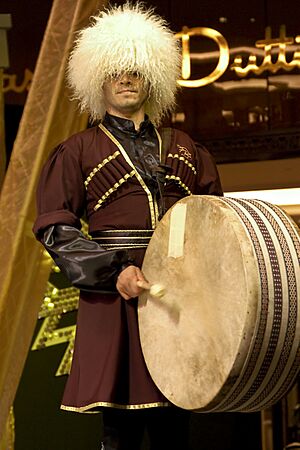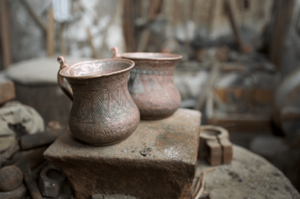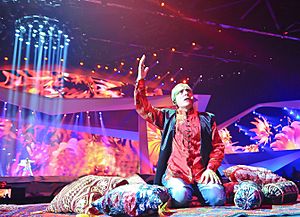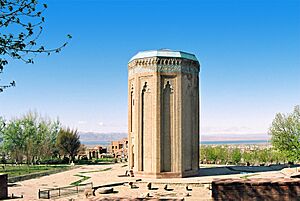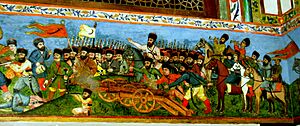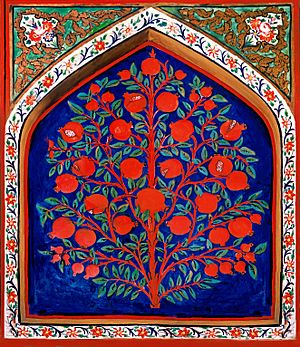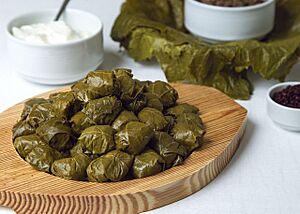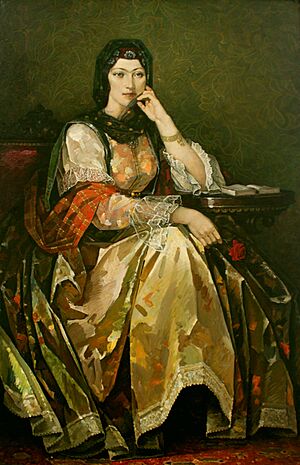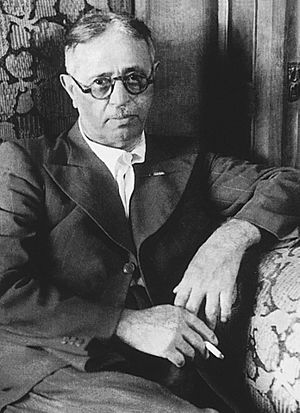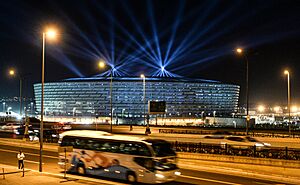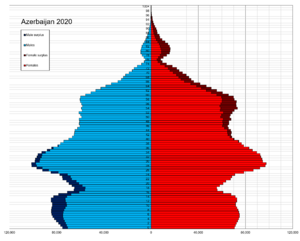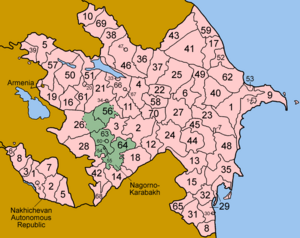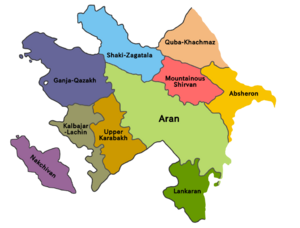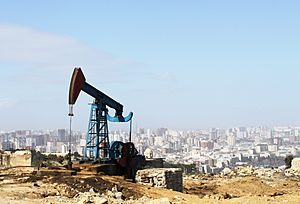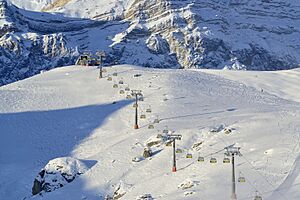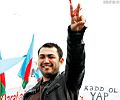Azerbaijan facts for kids
Quick facts for kids
Republic of Azerbaijan
Azərbaycan Respublikası (Azerbaijani)
|
|
|---|---|
|
Anthem: Azərbaycan marşı
|
|
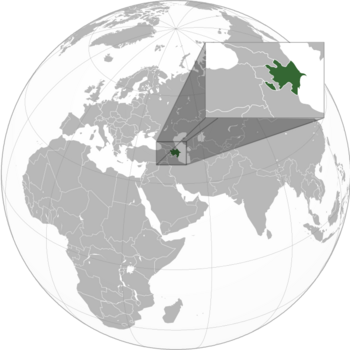 |
|
| Capital and largest city
|
Baku 40°23′43″N 49°52′56″E / 40.39528°N 49.88222°E |
| Official languages | Azerbaijani |
| Minority languages | See full list |
| Ethnic groups
(2019)
|
|
| Religion |
|
| Demonym(s) |
|
| Government | Unitary semi-presidential republic under a hereditary dictatorship |
| Ilham Aliyev | |
| Mehriban Aliyeva | |
| Ali Asadov | |
| Legislature | National Assembly |
| Formation | |
| 28 May 1918 | |
| 28 April 1920 | |
|
• Independence from Soviet Union
|
|
|
• Constitution adopted
|
12 November 1995 |
| Area | |
|
• Total
|
86,600 km2 (33,400 sq mi) (112th) |
|
• Water (%)
|
1.6 |
| Population | |
|
• 2022 estimate
|
10,353,296 (90th) |
|
• Density
|
117/km2 (303.0/sq mi) (99th) |
| GDP (PPP) | 2024 estimate |
|
• Total
|
|
|
• Per capita
|
|
| GDP (nominal) | 2024 estimate |
|
• Total
|
|
|
• Per capita
|
|
| Gini (2008) | ▲ 33.7 medium |
| HDI (2022) | high · 89th |
| Currency | Manat (₼) (AZN) |
| Time zone | UTC+4 (AZT) |
| Calling code | +994 |
| ISO 3166 code | AZ |
| Internet TLD | .az |
Azerbaijan (Azerbaijani: Azərbaycan), officially known as the Republic of Azerbaijan, is a country in the South Caucasus region. This area connects Europe and Asia. Azerbaijan shares borders with Russia to the north, Georgia and Armenia to the west, and Iran to the south. The Caspian Sea lies to its east. The capital and largest city is Baku. Azerbaijan became an independent country in 1991 after the Soviet Union ended.
Azerbaijan also includes the Nakhchivan Autonomous Republic. This is a special area that is separated from the main part of Azerbaijan. It borders Armenia, Iran, and Turkey.
Most of Azerbaijan is considered part of Western Asia. The United Nations calls it an Asian country. However, because of its location and history, Azerbaijan is also part of many European groups. For example, it joined the Council of Europe in 2001. Azerbaijan has strong connections with 158 countries around the world. It is also a member of 38 international organizations. In 2006, Azerbaijan was chosen to be a member of the United Nations Human Rights Council.
Most people in Azerbaijan are ethnic Azerbaijani. Other groups include Russians, Georgians, and more. The country's constitution does not name an official religion. However, Shia Islam is the main religion, followed by Sunni Islam. There are also smaller groups of Christians, Jews, agnostics, and atheists.
The name Azerbaijan comes from Atropates. He was a Persian ruler in ancient times.
Contents
A Look at History
For a long time, ancient Azerbaijan was known as "Caucasian Albania". It was mostly independent, even when controlled by the Roman/Byzantine and Persian empires.
After the Arab conquest in the 7th century, the country was greatly influenced by Islam. Its people became Muslim. This continued until the Russian Empire came into the Caucasus region.
From 1920 to 1991, Azerbaijan was a Communist country. It was part of the Soviet Union. Many Russians moved to Azerbaijan during this time. However, after Azerbaijan became independent in 1991, most Russians and other minority groups have left.
Nature and Wildlife
Azerbaijan is home to many different animals. There are 106 types of mammals, 97 types of fish, and 363 types of birds. You can also find 10 types of amphibians and 52 types of reptiles. The national animal of Azerbaijan is the Karabakh horse. This horse is a special mountain-steppe racing and riding horse. It is one of the oldest horse breeds in the world. Sadly, today the Karabakh horse is an endangered species.
Azerbaijan's plant life is also very rich. It has more than 4,500 types of higher plants. Because of its unique climate, Azerbaijan has more plant species than other countries in the South Caucasus. About 67% of all plant species found in the entire Caucasus region can be seen in Azerbaijan.
Learning and Education
Many people in Azerbaijan have a good education, especially in science and technology. In 1970, almost everyone aged nine to forty-nine could read and write. By 2009, the number of people who could read was 99.5%. This shows how important education is in Azerbaijan.
Azerbaijani Culture
Azerbaijan's culture has been shaped by many different influences. Today, ideas from the Western world and global trends are strong. However, traditional customs are still very important. Key parts of Azerbaijani culture include music, literature, folk dances, art, food, architecture, and movies.
Music and Folk Dances
Azerbaijani music has a long history, going back almost a thousand years. Traditional musical instruments include 14 types of string instruments, eight percussion instruments, and six wind instruments.
Some popular music styles are Mugham, Meykhana, and Ashiq. Mugham combines poetry with instrumental music. Singers express deep emotions when performing Mugham. Alim Qasimov, a famous Mugham singer, is considered one of the best singers ever. Meykhana is a type of song performed without music. Several people usually make up words about a topic on the spot. Ashiq music blends poetry, storytelling, dance, and both singing and instrument playing. It is a very important symbol of Azerbaijani culture.
Azerbaijan first took part in the Eurovision Song Contest in 2008. They hosted the contest in 2012 in Baku.
There are many Azerbaijani folk dances. Dancers wear traditional clothes like the Chokha for festivals. Most of these dances have a very fast and lively rhythm.
Amazing Architecture
Azerbaijani buildings often mix styles from the East and West. Many old treasures still stand today. These include the Maiden Tower and the Palace of the Shirvanshahs in the Walled City of Baku. There are also plans for the Azerbaijan Tower. It is designed to be one of the tallest buildings in the world.
Movies and Films
The movie industry in Azerbaijan started very early, in 1898. Azerbaijan was one of the first countries to make films. After gaining independence in 1991, the first Baku International Film Festival East-West was held in Baku.
Delicious Food
Traditional Azerbaijani food uses many fresh vegetables and herbs. Herbs like mint, cilantro, dill, basil, and parsley are very popular. They are often served with main dishes. The national dishes show the varied landscape of the country. They use fish from the Caspian Sea, local meats (like lamb and beef), and many seasonal vegetables. Saffron-rice plov is the most famous dish. Black tea is the national drink.
Literature and Stories
The earliest known Azerbaijani writer was Hasanoghlu. He wrote poems in both Persian and Turkic. Classical Azerbaijani literature began in the 14th century. Famous poets from this time include Gazi Burhanaddin and Haqiqi. The well-known Book of Dede Korkut has stories from the 16th century. It shares 12 tales from the oral traditions of Oghuz nomads.
In the 17th and 18th centuries, poets like Qovsi of Tabriz and Shah Abbas Sani continued the unique styles of Fizuli and Ashik poetry.
The first newspaper in Azerbaijani, Akinchi, was published in 1875.
Popular Sports
Sports are very important in Azerbaijan. Both traditional and modern sports are enjoyed. Freestyle wrestling is seen as Azerbaijan's national sport. The most popular sports are football and chess. Azerbaijan hosted the 2012 FIFA U-17 Women's World Cup.
Futsal is also very popular. The Azerbaijan national futsal team came in fourth place in the 2010 UEFA Futsal Championship.
Backgammon is a very popular game in Azerbaijani culture. Many people play it.
People and Population
| Ethnic composition (2009) | |
|---|---|
| Azerbaijani | 91.60% |
| Lezgin | 2.02% |
| Armenian | 1.35% |
| Russian | 1.34% |
| Talysh | 1.26% |
| Other nations | 2.43% |
In July 2011, Azerbaijan had about 9,165,000 people. About 52% of them lived in cities, and 48% lived in rural areas. About 51% of the people were female.
Around 3 million Azerbaijanis live in Russia, many of them working there.
In 2005, the most common cause of death was from respiratory diseases.
Regions and Cities
Azerbaijan is divided into 10 economic regions. It also has 66 rayons (districts) and 77 cities. Eleven of these cities are directly managed by the republic's government. The Nakhchivan Autonomous Republic is also part of Azerbaijan. The President of Azerbaijan chooses the leaders for these areas. However, the government of Nakhchivan is elected by its own parliament.
|
|
|
Note: The cities under the direct authority of the republic are in italics.
Azerbaijan's Economy
Azerbaijan's economy relies on industry, agriculture, and services like tourism. The most important part of the economy is the energy sector. This is because Azerbaijan has large amounts of crude oil and natural gas. These resources are the main reason for the country's economic growth. Even so, many people work in services and agriculture. The energy boom has brought a lot of foreign direct investment. This has made Azerbaijan's economy one of the fastest growing in the world.
After becoming independent in 1991, Azerbaijan changed from a government-controlled economy to a market economy. The government has mostly finished selling off agricultural lands and many state-owned businesses to private owners. Azerbaijan continues to make economic reforms. Old economic systems are slowly being replaced. After independence, Azerbaijan joined important international groups. These include the International Monetary Fund and the World Bank.
Azerbaijan's currency is the Azerbaijani manat (₼). It is divided into 100 qəpik. The manat became the national currency in 1992, replacing the old Soviet ruble. The Central Bank of Azerbaijan was also created in 1992. It is responsible for printing the national currency and managing all commercial banks.
More to Explore
- Democratic Republic of Azerbaijan (1918-1920)
- Azerbaijan Soviet Socialist Republic (1920-1991)
- Azerbaijan at the Olympics
- Water bodies of Azerbaijan
Images for kids
-
Petroglyphs in Gobustan National Park dating back to the 10th millennium BC indicating a thriving culture.
-
The Karabakh horse is the national animal of Azerbaijan.
-
The Bibi-Heybat Mosque in Baku. The mosque is built over the tomb of a descendant of Muhammad.
-
Mirza Gadim Iravani – Portrait of sitting woman (National Art Museum of Azerbaijan)
-
Bahruz Kangarli – Landscape with mountains (National Art Museum of Azerbaijan)
-
Azim Azimzade – Ruins of Reichstag (National Art Museum of Azerbaijan)
See also
 In Spanish: Azerbaiyán para niños
In Spanish: Azerbaiyán para niños




